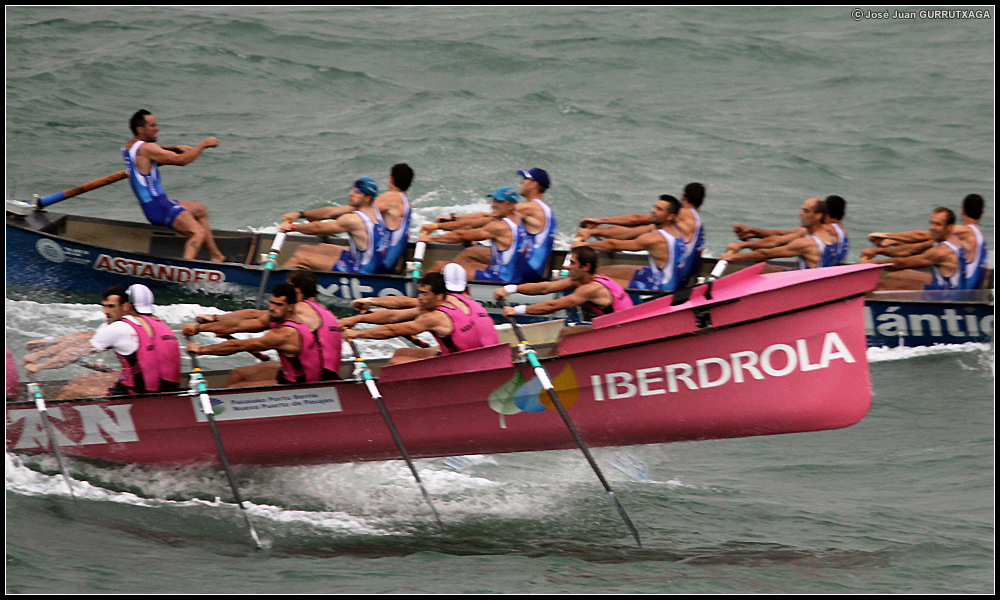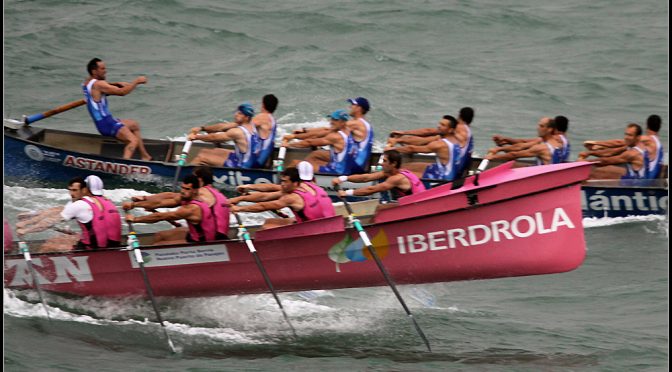As one might suspect for a people so intimately connected to the sea, the Basques have a special relationship with the ocean. From a long history of fishing and whaling, to exploring distant lands, the Basques have taken to the seas like literal fish to water. Combined with a competitive spirit, it was only natural for Basques to extend their competitions to the water. The estropadak, or regattas of traineras, is the epitome of the mixing of these elements.

- The trainera is a long thin boat, typical of the Cantabrian coast. These boats grew out of the whaling and fishing industries. Speed was of essence in whaling, as the first to a sighted whale was able to claim it. Similar, the first boats back to the docks with fish got the best price. Thus, speed was crucial and the trainera, consisting of 13 crew and 1 cox (helmsman), evolved to be fast.
- The oldest mention of trainera regattas comes from the early 1700s. According to an anecdote recalled by José Luis Muñoyerro, the towns of Mundaka and Bermeo had an ongoing dispute over the island of Izaro, close to Mundaka, but controlled by Bermeo. They decided to have a race to determine which town it should belong to. On July 22, 1719, two teams raced for the island, with the team from Bermeo reaching it first, claiming the island for their town.
- The same boats used for fishing were used for racing until 1916, when Vicente Olazabal build the Golondrina, a special boat for the racing crew of Getaria. In the following years, Eusebio Lazcano, a carpenter from Getaria, continued to build custom boats. As these were never destined to be used for fishing, their form evolved, with the width and weight decreasing to maximize speed.
- While the oldest trainera regatta is from Santander, started in 1859, the most famous is the Kontxako Estropadak, Kontxako Bandera, or Regattas of San Sebastián, which began in 1879. The course raced today is 3 miles, a distance set in 1898. Orio has won the race the most, a total of 32 times, while the fastest time belongs to Castro Urdiales, with a time of 18:59.94, set in 2006.
- The latest edition of the Kontxako Bandera was held earlier today. On the men’s side, Hondarribia won their third consecutive Bandera with a combined time for the two races of the final of 39:26.52 (the final consists of two races amongst the eight finalists) while Orio won the women’s race with a combined time of 21:59.80. (The women’s course is 1.5 nautical miles, or half that of the men’s.)
- It is only recently that women began officially racing in the regattas, but there is evidence that women participated in rowing teams. Female rowers were called batelerak, a name taken from the batel, a smaller boat with 4 rowers. The batelera dantza, performed by women using oars, also points to this history.
Primary sources: Wikipedia: Kontxako Bandera; Wikipedia: Trainera; Auñamendi Entziklopedia. Regatas de Traineras. Enciclopedia Auñamendi. Available at: http://aunamendi.eusko-ikaskuntza.eus/es/regatas-de-traineras/ar-102442/


